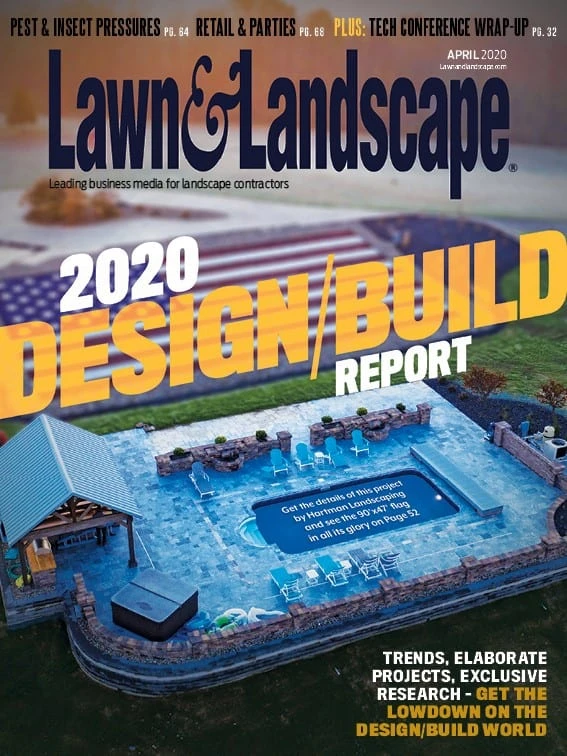

Go big and stay home. This attitude is what Benjie Lewis is seeing among clients in his Kansas City, Mo., market, where projects have increased in scope during the last couple of years. Rather than the 350 square-foot paver pad with a firepit kit, his crews are building out spacious outdoor living rooms that are at least 600 square feet in size. “Instead of a basic patio addition, we are seeing people go, ‘I want a $15,000 fireplace or a 12-foot long outdoor kitchen with space for a grill, flat-top griddle and my Green Egg,” says Lewis, owner and president. “We are seeing fewer people do projects in stages and more saying, ‘Let’s do it the way I want to do it and do it all now,’” Lewis adds, noting that clients seem more likely to take out a home equity loan and invest in the space they really want rather than going into a half-hearted design/build project.
In Florida, Diane Ramos at Earthly Design & Resources is fielding calls for xeriscape and low-maintenance planting projects. “We are doing rock installations and more cactus-type plants,” she says, noting that her Lake Worth, Fla., business with 10 employees is seeing stable growth.
Meanwhile in the Sonoma Valley area of California, design/build projects are focused on rebuilding outdoor living spaces after the wildfires, says Peter Estournes, horticulturist and president of Gardenworks in Healdsburg. In the rural wine-country setting 70 miles from San Francisco where his business operates, many projects are for second homes. “They are looking for landscapes that fit into the region’s motif – lavender, decomposed granite pathways,” he says. “We are seeing a downturn on large lawn areas and an upturn on artificial turf.”
Across the country, the design/build demand has been healthy during the last couple of years, and the business owners we spoke to have experienced steady volume, nice backlog and profitability, with some noting that revenues are up because of more expensive projects. “I’d say people are spending about 50% more than what we saw a couple years ago,” says Matthew Kelly, president of The Turf Boss, Zionsville, Ind. “People are staying at home,” he says, adding that his service area is one of the fastest growing in the state. “People are building new houses or moving into new houses and investing.” From linear design to landscape lighting enhancements, design/build firms are building out complete outdoor spaces that include features clients might not have spent money on five years ago.
Lights and Water.
More interest in water features and landscape lighting has opened up project opportunities for Classic Landscapes in Hampton, Ga. “When the recession was in full gear, we were not doing as many pondless waterfalls and waterfalls,” says John Newman, president.
The same is true for lighting. “In the last two years, more people are asking for landscape lighting, and we promote lighting zones and different fixtures – we are doing some creative lighting, but more often than not, we are designing a system,” Newman says, noting that his South Atlanta market will spend on landscaping, “but it’s not extremely high-end.”

Clean-Lined Pavers.
Newman is doing more work with pavers, and other design/build businesses expressed the same client demand for hardscape. Lewis says paver layouts are more linear. “We see less swooping curves and more 90-degree edges on everything,” he says of the overall landscape design aesthetic of most projects. “The same is true with pools. I have friends who build pools and they are seeing less lagoon-style designs and more rectangles.”
Kelly’s client base in Indiana is asking for the same clean look. “I wouldn’t say our designs are contemporary, but there is a trend away from the smaller paver and tumbled paver look toward straight-lined layouts and designs,” he says.
There’s a move away from concrete, Lewis says. While about 10% of his clients go for natural stone such as flagstone and bluestone, the majority are opting for higher-end pavers. “When we only had the cobble pavers to offer, many people were like, ‘I don’t like that,’ but with the decorative pavers available and more design options, more people are choosing this rather than stamped concrete,” Lewis says.
Dennis Lovell, president, Landscape Service Co., Lenexa, Kan., has stayed out of the hardscape side of design/build so far. “We just haven’t found it to be that profitable,” he says. Because his company focuses on landscape renovations and only did a handful of hardscape projects each year, his business is not optimized with the labor and efficiencies to maximize returns on a paver job. “We focus more on plant material, accent landscaping, boulders, fountains, pathways and landscape lighting,” he says.
In Pittsburgh, Pa., Amanda Linder of Rolling Hills Landscapes says their hardscape business focuses on building walls. She agrees that margins can be tight on hardscaping. “I think a lot of people assume that because it’s hardscape, there is more profit in it because it’s a bigger ticket item, but the materials are much more expensive than mulch,” she says.
Many contractors in her area have entered the hardscape business and created competition – but not the kind that Rolling Hills Landscapes entertains. Those upstarts build front-yard walls, which are common in this region. “Eight out of 10 walls installed are in terrible condition because of improper drainage, so we do a lot of replacements and new construction,” Linder says.
Rolling Hills Landscapes takes on the more complex projects, which is how the company built a niche in the region. Its patio work is fairly simple – 400 to 600 square-foot spaces – but the work required to build up a hilly backyard into usable landscape requires the equipment and expertise.
Fire Pit and Fireplaces.
When clients learn of the price difference between a fire pit and a fireplace, most go for the pit, Newman says. The feature delivers what they want – a warm glow and a gathering space. While Newman does some gas-powered fire pits, most of them are wood burning in a natural area that is visible from inside the home. Generally, Classic Landscapes is not installing kits because clients are asking for larger fire pits.
Estournes says fire pits are in greater demand than outdoor kitchens in his California market. He installs some kits and other projects are custom. “We’ll do whatever the client wants,” he says, walking them through the options and costs: gas vs. wood, kit vs. custom.
If they want a wood-burning fire pit, there must be a cooking element attached to it because of regulations and the wildfire concerns in his region. “We are going to see more gas-burning fire pits because of that, though they are trying to ban natural gas in our area for housing, so we’ll see what happens,” he says.
Lovell loves the fire pit kits. “All you have to do is set the base properly,” he says. These kits also keep a fire pit affordable for clients.
However, Lewis finds that clients who are interested in incorporating materials that match their homes want much more than a kit can offer. “They are saying, ‘Let’s do it bigger – can we make the fire pit taller?’” he says. “Some ask for a top cap made out limestone rather than the traditional trap cap, or they want to match the veneer to their homes. We are seeing less kitting and more customization, for sure.”

Outdoor Structures.
About half of the design/build projects Kansas City Hardscapes completes includes a cover – whether a pergola, or a roof complete with gutters. That’s roughly a 25-percent increase in demand for this type of project, Lewis says. “A lot of times, they’ll want a ceiling fan, too, which makes it more of an outdoor room.”
The vertical element is appealing to clients, he adds. “As opposed to people asking for a flat patio, they want some privacy,” he adds, noting that a fireplace can also provide this element when combined with a covered structure.
Steady Planning.
Labor is a challenge across the board, and with many businesses reporting design/build backlog, the way to grow is to add a crew, if possible. “By January 1, we booked our schedule through the summer, so we are not putting anything into new marketing – it’s all word of mouth and organic growth,” Kelly says. “Our challenge is to hire people who are qualified to start another crew so we can go out and double our capacity on what we can schedule.”
Estournes says that his business has not grown in team size, but they’re working smarter and are more profitable. “We have created efficiencies, training and career path development to improve profitability on projects,” he says, noting that keeping up with wages that accommodate California’s cost of living can be a challenge. This is where career path development comes in. “Every year, we make an adjustment for California’s inflation rate and we do merit-based evaluations,” he says.
Ramos’ team in Lake Worth, Fla., is stable. And, Earthly Designs & Resources hopes to increase the commercial construction side of the business with advertising, she says. “It’s about eating their expectations and having the insurance coverage,” she says.
As for equipment investments, Ramos says her business rents what they need to complement its track loader. She expects to spend on machines this year. Most others said they will hold tight on capital spending this year.
But prices are adjusting to accommodate higher labor rates and cost of living. “We have raised pricing some – because the economy is strong, the labor market is tight, and if you have been able to weather the storm and stay in business and you can perform, that commands a value in the marketplace,” Newman says.
Growth has been steady Newman adds. “I feel like we are poised for good days ahead,” he says.
However, the novel coronavirus COVID-19 has caused businesses in every industry to wonder: Will this virus open the door for a recession like the one we saw a decade ago? No one can be sure. “Who’s to say – with entertainment going away during the next 60 days or so, people might spend more on the landscape – unless the market totally crashes,” Lovell says.
Project sizes have been on the rise, and Lewis can’t say for sure if that will continue. The backlog of projects booked through August is certainly healthy. “Some people might figure, ‘I’m not spending $15,000 on a European vacation this year, so let’s do something at home,” he says. “The problem is their investments have dropped so maybe they won’t spend $60,000 on an outdoor living space.”
No one’s really sure, and an impact on business might take a while to feel, Estournes says. “When the crash happened in 2008, we had a 9-month lag before it caught up with us,” he says. “We haven’t heard from any of our current clients who are engaged in the design process or beginning to install that there is any worry on their part.”
A full backlog is a buffer. Overall, Newman reports, “I think it’s going to be a great year.”

Explore the April 2020 Issue
Check out more from this issue and find your next story to read.
Latest from Lawn & Landscape
- SiteOne names Carrothers VP of agronomic business development
- Batman and business
- Ever-changing landscape of SEO
- Fleetio acquires Auto Integrate, raises $450M in Series D funding
- Davey Tree expands in St. Paul, promotes Ostlie to district manager
- Schill Grounds Management taps 3 for senior leadership roles
- HD Hyundai Construction Equipment North America adds to wheeled excavator lineup
- High maintenance






